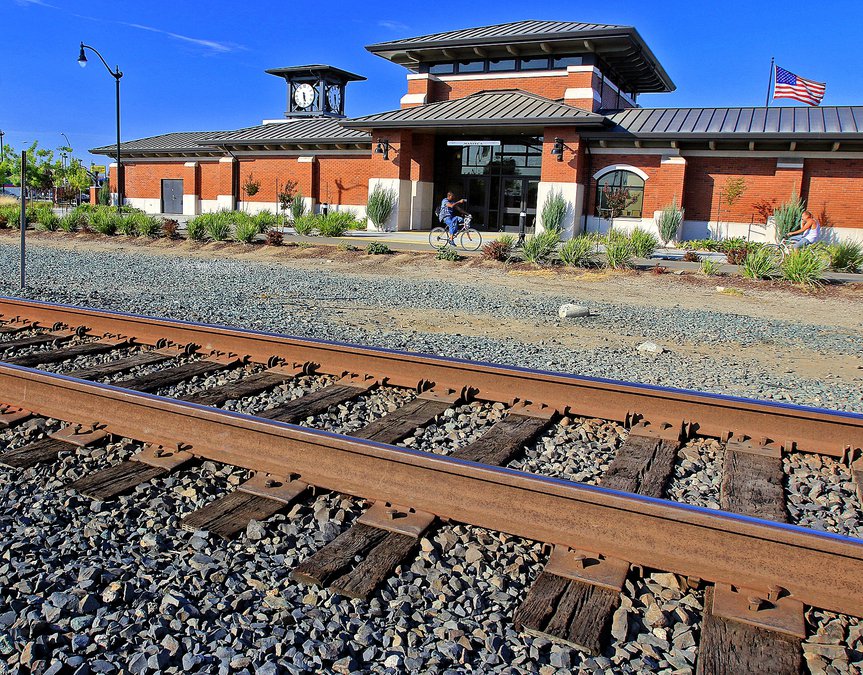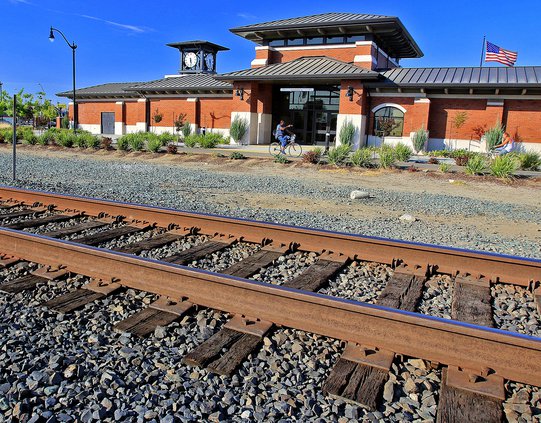Bay Area and Sacramento commuters within seven years are likely to have five options where they can catch a train — all within eight miles by car of downtown Manteca.
That will include one train daily from downtown Manteca to San Jose and two trains daily from downtown Manteca to Sacramento.
A decision last week by the Tri Valley-San Joaquin Regional Rail Authority to adopt a preferred alternative to provide rail service connecting ACE to BART means a proposed ACE North Lathrop station will be built as a transfer station on land that is now part of the Sharpe Depot site.
That will serve as the initial valley terminus of the first phase of the Valley Link rail service connecting with the existing Dublin/Pleasanton BART station. A Valley Link station would also be built at River Islands at Lathrop.
The endeavor to extend the Altamont Corridor Express to Ceres by 2023 means a passenger platform will be added to the Manteca downtown transit center. A station would also be built near downtown Ripon.
The existing Lathrop-Manteca station just over the western city limits on Yosemite Avenue will stay in place. The possibility of moving that station a mile to the south to be closer to the 120 Bypass at a location near the future extension of Daniels Street has been put on the back burner. Such a station would cost $25 million.
“We decided to keep both stations (the existing Lathrop-Manteca ACE station and the proposed Sharpe Depot ACE/Valley Link transfer) because of the large ridership in the area,” noted Manteca Councilwoman Debby Moorhead who serves on the regional rail authority.
It is likely the Sharpe Depot location would have a significantly larger parking lot than the Lathrop-Manteca station.
Moorhead noted with $1 billion set aside for the two projects — the ACE extension to Ceres and the Valley Link to BART — it means both will become a reality.
Amtrak service from Stockton to Sacramento started earlier this year.
The next phase for Valley Link is a feasibility study and environmental review scheduled to be completed by July 2019.
The Valley Link will run trains during peak hours every 12 minutes from the proposed Greenville Road station in Livermore to the Dublin/Pleasanton BART station and every 24 minutes from the North Lathrop station. Valley Link would operate from 5 a.m. to 8 p.m.
Four ACE trains currently depart from Lathrop-Manteca between 4:20 and 7:05 a.m. to San Jose. Initially three ACE trains would originate from Ceres and stop in Modesto, Ripon, and downtown Manteca. All three would stop at the North Lathrop station to allow using Valley Link to connect with BART to reach San Francisco. One train would continue on to San Jose and the other two head to Sacramento.
The two systems and proposed stations would make the Manteca region the most connected area for intercity commuter rail service in Northern California if not the entire state.
Within eight miles of the heart of Manteca there would be five stations — downtown Manteca, Lathrop Manteca, Lathrop-Manteca, North Lathrop (Sharpe Depot), River Islands at Lathrop, and Ripon. Lathrop would be right behind Manteca in the eight mile radius with three stations within its city limits as well as downtown Manteca.
And while the likelihood of driving against the commute to board a train in Manteca seems unlikely, Lathrop would be the only city in the north state with three intercity rail stations within its boundaries.
Besides stations at Greenville, River Islands and North Lathrop proposed Valley Link stations in the first phase include one at Isabel Street in Livermore, Mountain House, and Downtown Tracy. A second phase would extend Valley Link from North Lathrop to the Stockton ACE and Amtrak station.
Beyond providing a much sought after commuter link by many who live in the 209 and work in areas served by BART between Dublin/Pleasanton and San Francisco, the BART to ACE link would also connect 500 miles of commuter and intercity rail lines with more than 130 stations in the Northern California metroplex.
It would ultimately be feasible to catch a train in Merced and — with connections that are station-to-station or very short shuttle runs — travel to downtown San Francisco, downtown San Jose, San Francisco International Airport, Stockton, Sacramento, Lawrence Livermore Lab, Levi’s Stadium, and the Oakland Coliseum among other destinations.
You could step on a train in downtown Manteca, Lathrop-Manteca, North Lathrop, Ripon or River Islands to access that 500-mile network that includes 130 stations making mass transit a viable alternative to commute to jobs, travel to reach entertainment venues, shop, attend school, and other purposes.
Agencies involved with the Tri Valley-San Joaquin Valley Regional Rail Authority are the cities of Manteca, Lathrop, Stockton, Tracy, Livermore, Pleasanton, Dublin and San Ramon, the Town of Danville, Mountain House Community Services District, San Joaquin and alameda counties, Livermore Amador Transit Authority, BART, and the San Joaquin Regional Rail Commission (ACE).
To contact Dennis Wyatt, email dwyatt@mantecabulletin.com









